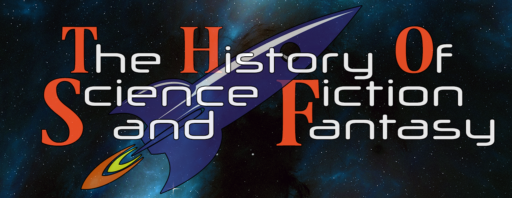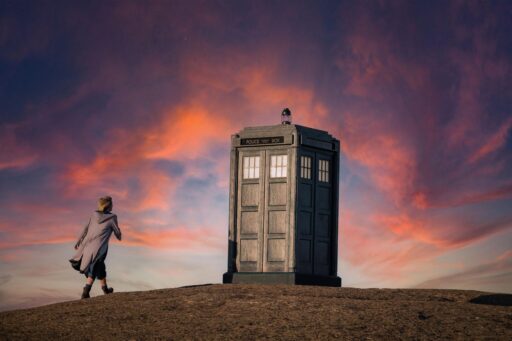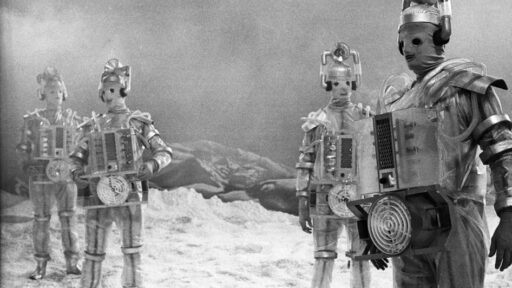The first decade of the 20th century continued the remarkable scientific progress of the previous century. Two events in particular informed the “scientifiction” writing of this period. In 1903 the Wright Brothers built and flew the first airplane, something that would inspire a lot of stories.
But probably even more significant was Albert Einstein’s Theory of Special Relativity which he published in 1905. As well as giving us the only equation most people know (E=mc2), Special Relativity gave us the concepts of Time dilation, Length contraction and relativity of simultaneity. These are things that science fiction writers still use in stories today.
Wells and Verne
The established masters of the genre both continued to write and publish in this decade. In 1904 Jules Verne published Master of the World which featured a ten meter long vehicle that could be a speedboat, submarine, car or airplane. The vehicle was able to travel at 150 mph on land and 200 mph in the air. Verne went so far as to have the vehicle be invisible at the speed of 150 mph which at that time was an unheard of speed.
HG Wells published a series of stories during the decade including The First Men in the Moon which tells the story of a trip to the moon by the two protagonists and their encounters with the Selenites there. This story was an influence on the writings of C.S Lewis which we’ll reach later in this series.
1908’s The War in the Air was remarkably prophetic in anticipating World War I and the use of airplanes in warfare.
Enter Cinema

Georges Melies was an early pioneer of science fiction cinema. Inspired by Jules Verne and H.G. Wells he released Le Voyage dans la Lune (The Voyage to the Moon) in 1902 which showed a spacecraft launched by a powerful gun traveling to the Moon.
In 1904 Melies produced Voyage a Travers L’impossible (An Impossible Voyage) a half hour picture that included a train which morphed into a spaceship.
Both of these are milestones in the cinematic medium and are still available on DVD and Blu-Ray today.
Magazines
It would be some years before magazines became the driving force of science fiction writing, but much of the fiction of the era was serialized. In 1902 Park Winthrop wrote The Land of the Central Sun about people inside the earth. While in 1903 William Cook wrote about robots in A Round Trip To The Year 2000. Both stories were serialized in Argosy Magazine which is considered the first “pulp” magazine.
In 1904 Hugo Gernsback arrived in the United States. Gernsback would play a pivotal role in the development of science fiction. Four years later Gernsback would launch his first magazine “Modern Electrics”.
In 1905 Rudyard Kipling published With the Night Mail in McClure’s Magazine. Kipling is not generally regarded as a fantasy or SF writer since the clear divisions simply did not exist back then. His story envisages a future where airships or “dirigibles” rule the skies.
Astronomer Garrett P. Serviss’ story A Columbus of Space was serialized in All-Story Magazine in 1909. The story is about an atomic rocket travelling to Venus.
New Blood
Many other authors began to essay this new genre of fiction. George Griffith’s A Honeymoon in Space from 1900 takes a newly married couple on a whirlwind tour of the solar system. And is in many ways typical of the stories of the time, featuring an English explorer who marries and American girl, goes into space and fights Nazi style Martians.
In 1901 M. P. Shiel published two books which form what is perhaps the first future history series in science fiction. The Lord of the Sea features the founding of an Israel like Jewish homeland. While The Purple Cloud is about the last man on earth desperately looking for the last woman on earth.
G. K. Chesterton’s The Napoleon of Notting Hill is an interesting entry in the genre. Set in late 20th century London, it depicts a Government where quite simply no one cares what happens and technology halted back in 1904.
In 1905 Edwin Lester Arnold published Lt. Gullivar Jones: His Vacation (re-released many years later as Gulliver of Mars). The book was actually very poorly received and Arnold stopped writing fiction as a result. However it is thought that this book may have partially inspired Edgar Rice Burrough’s Barsoom series which was also set on Mars.
A particularly important non-fiction publication was Mars and its Canals by Professor Percival Lowell in 1906 which contained his theories about the Martian civilization that must have built the “canals”. This heavily influenced science fiction authors for a long time afterwards.
The Iron Heel by Jack London (1907) has been described by some as a forerunner to the “soft” science fiction of the 1960s and 70s. This negative utopia looks at the rise of an oligarchy in the United States and its emphasis is on social changes and politics rather than technology.
In The Smoky God; or, A Voyage to the Inner World (1908) Willis George Emerson’s treads a similar path to Jules Verne with a sailor sailing through an entrance to the earth’s interior at the North Pole.
1909’s The Machine Stops is an unusual story from E. M Forster (much better known for works like A Passage to India, Room With A View and Howard’s End) tells of a future humanity who isolate their entire lives living one person per apartment and communicating with video screens.
It’s interesting to note that at this point Science Fiction was not nearly as ghettoized as it has been for much of it’s history. Perhaps because it wasn’t even called science fiction it was simply seen as another avenue for writers to explore subjects.
Discover more from Veristopia
Subscribe to get the latest posts sent to your email.








